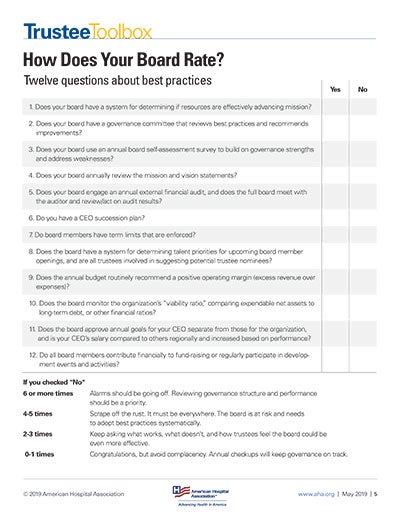
Board Culture
Becoming a First-Rate Board
How does your approach to governance compare with best practices?
By Paul J. Taylor
Practical
Governance
How would you rate the quality of your board? What standards or measurements should you use?
Knowing the difference could make a crucial difference to the future of your organization. Top-notch governance is an indispensable ingredient in the recipe to make the entire organization successful. Other factors may contribute — some even markedly — but consistent success is possible only when a board is firing on all cylinders.
A compelling mission and dynamic chief executive officer can drive progress. But the board hires and is responsible for the CEO. And the board is the ultimate authority on mission, strategy, goals and resourcing. Governance leadership and engagement is a fulcrum to the achievements of every corner of the organization.
Trustee Talking Points
- The board is the ultimate authority on mission, strategy, goals and resourcing.
- Yet boards are often too busy governing to be deliberative about how they are governing.
- Fulfilling duties includes actively engaging in practices that promote good governance.
- A review of best practices enables the board to reflect on opportunities for improvement.
Yet trustees who require introspection and performance improvement from their health care organizations or in their own professional lives are often too busy governing to be deliberative about how they are governing.
Consider the marching orders of football coach Bill Belichick of the New England Patriots. Love him or hate him, Belichick is crystal clear: “Just do your job … in every aspect of the game for all 60 minutes of the game.” A recent Super Bowl shows again that his approach has made his team the most consistent winner season in and season out. The rule is relentless introspection. Complacency is forbidden.
Comfortable contentment can become a hidden risk for any organization. What does it mean to “just do your job” as a board member? The answer begins with three core fiduciary duties:
- Duty of care: Exercising reasonable due diligence, prudent judgment, thoughtful prudence and oversight of operations.
- Duty of loyalty: Putting the good of the organization first, ahead of any personal or other consideration, and having systems to avoid conflicts of interest.
- Duty to purpose (obedience): Sticking to the mission, complying with the law, and avoiding decisions that could endanger reputation or run afoul of regulators.
Here are a dozen suggestions for how to fulfill those duties while also strengthening both governance and organizational culture and performance. Doing your duty is not just about success; it is also about actively engaging in practices that promote good governance. Ask your board members to review and reflect on how your board compares with the following, then take the quiz "How Does Your Board Rate?":
1. Know your “ABCs” (Always Be Curious)
Are agendas, reports, meetings and committees just the “same old”? The problem isn’t sticking with the usual routines. It’s in not asking if the old ways still work in new times. The challenge for an engaged trustee is in the question, “How do we know what we don’t know?” Be curious. How is success measured? How is the mission fulfilled? Unmet needs? Could more be done? Less? Are metrics or dashboard tools used to evaluate effectiveness? Does an updated strategic plan support the mission? Is it enthusiastically backed? Questioning is inherent to a board’s due diligence responsibilities; it needn’t be adversarial.
2. Mind your own business
Ask if it’s time for a governance reality check. Form a governance committee to explore and share best practices. Conduct a board self-assessment survey and create a long-term plan to build on strengths and address weaknesses. Consider an annual retreat focused on effective governance. Systematically put together policies to codify the reasons, timing and other details of recurring board practices and actions: financial management and procedures like budgeting, nominations, conflicts of interest, executive compensation, insurance coverages, and the like. These policies can avoid reinventing the wheel of explanation for every meeting — and can be invaluable to new trustees as well as a reminder to experienced trustees.
3. Support the CEO by accountability
Collaborate with your CEO on meaningful personal goals. Link them to organizational goals. Monitor results several times a year and conduct a formal performance review annually. Compensation should demonstrably be linked to performance and aligned with external compensation benchmarks of other health care organizations of comparable size, capacity and geography. The full board should have the final say on goal setting, measurement and compensation.
4. Mission: the ultimate touchstone
Organizations, especially nonprofits, exist for altruistic purposes called “mission.” Boards are responsible for ensuring that their organizations are dedicated to and focused on accomplishing the mission. All that’s done or proposed should pass through the filter of “Does this further our mission?” Be cautious of ideas to expand into commercial enterprises normally conducted by for-profit organizations. Some may legitimately support your organization. However, devoting time, resources and energy to chasing dollars can be a diversion, if not an expensive financial mistake, with consequences for the organization’s credibility.
5. Pay attention to dollars and cents
The old axiom “No margin, no mission” should figuratively be carved in stone at budget time. Beware of proposals with red ink or those that depend on speculative funding sources or ramped up expenses without counterbalancing revenue sources, or that propose crushing debt. Financial reports should be issued regularly and reviewed at every board meeting. Boards should have several trustees who qualify as financial experts and can help vet these proposals through the Finance Committee and with the full board.
6. Integrity: the crown jewel
Integrity should be your most important asset. Call it honor, honesty, truthfulness or character; but ensure it is a common thread through the fabric of all that the organization does and in the actions of every trustee. Integrity allows everyone to sleep better and engenders respect and esteem. The West Point Cadet Prayer is spot on: “Choose the harder right over the easier wrong, and never be content with a half-truth when the whole can be won.”
7. In controls we trust
A headline in the January 28, 2018, Boston Sunday Globe read, “Theft at nonprofits shockingly common.” Financial controls and double-checks should be monitored by a Finance Committee and validated by external auditors. Trustees also should understand legal and regulatory requirements and deadlines and ensure complete compliance. Review the annual Federal 990 tax return required of nonprofits, as well as similar requirements by state governments. These filings contain a wealth of information that should be must-reading for every trustee.
8. Apply an ounce of prevention
Create systems to prevent or prepare for events that could damage progress, sustainability, reputation, assets or employees, or that produce legal liability. For example, a change in CEO is one of the biggest potential disruptions for an organization; having a thoughtful CEO succession plan should be a priority. The boards of organizations of every size should ensure that basic risk-prevention techniques and management are in place and regularly updated. What potentially could go wrong? Which risks are more likely than others? Can they be insured against? Some risks may be unavoidable, but regular planning can lessen the impact of threats and/or make managing them easier.
9. All trustees are not the same
Every board has some members who may be less effective or engaged than others. Candid board self-assessments can reveal that some long-time trustees may not understand reports they have reviewed for years. Should the trustee who is a finance expert know about or remember the nuances of community outreach? Should the consumer advocate or community representative be familiar with clinical quality metrics? Should physicians be experts on legal and regulatory requirements? Survey trustees at least annually about what they wish they knew more about. Effective approaches include refresher orientations, one-on-one sessions with expert staff members, or participation in association webinars or conferences. Avoid one-size-fits-all approaches. All board members will not have the same needs.
Trustee Takeaways
- Consider forming a governance committee to explore and share best practices.
- Conduct a board self-assessment (such as the accompanying 12-question quiz).
- Create a long-term plan to build on your board’s strengths and address weaknesses.
- Ask your members at least annually to learn what they wish they knew more about.
10. Know when to fold 'em
Debates about term limits are archaic or the refuge of trustees who want to stay forever. Few, if any, trustees are as energized or as objective after years of service than in their initial years. They also may not be as willing to undertake leadership positions or take on new initiatives. Might the experience of some veterans be lost? Recruit them for other volunteer opportunities. If their talents are still needed in governance, bring them back after a hiatus.
11. Everyone's an "all-star"?
Which best practice is most effective in creating a high-performing board? It is what drives success in most enterprises: picking the right people. But many boards choose new trustees informally, based on personal or business contacts, reputation or one trustee’s recommendation. No matter how candidates are sourced, selecting new trustees informally is risky. The process should begin with screening criteria forged by the entire board. One successful model has three filters: (1) “must” characteristics for every trustee; (2) collective talents that should be on the board as a whole; and (3) desired variables that could be priorities periodically. After deciding the backgrounds most needed, trustees can then suggest candidates who fit the priorities. Some boards require that every trustee be a potential leader, resulting in a board of all-stars within a few term cycles.
12. Be a true believer
Of all that a board member can bring to the governance table, nothing is more important than enthusiasm bordering on passion. Be engaged. Work on committees. Support fund-raising. Introduce others who should know about your organization or could help it. Merely providing oversight is no longer an adequate role for individuals to belong to an organization’s governing board. Each seat on the board should be filled by someone dedicated to the highest standards of governance on behalf of the communities your organization serves.
In summary: Serving on a board is not honorific, nor is it just a matter of showing up to provide oversight. It means engaging a trustee’s lifetime of experience and common sense to be an activist in supporting a mission, those who benefit from the organization’s good works, and those dedicated to realizing a vision. In a nutshell, just do your job.

